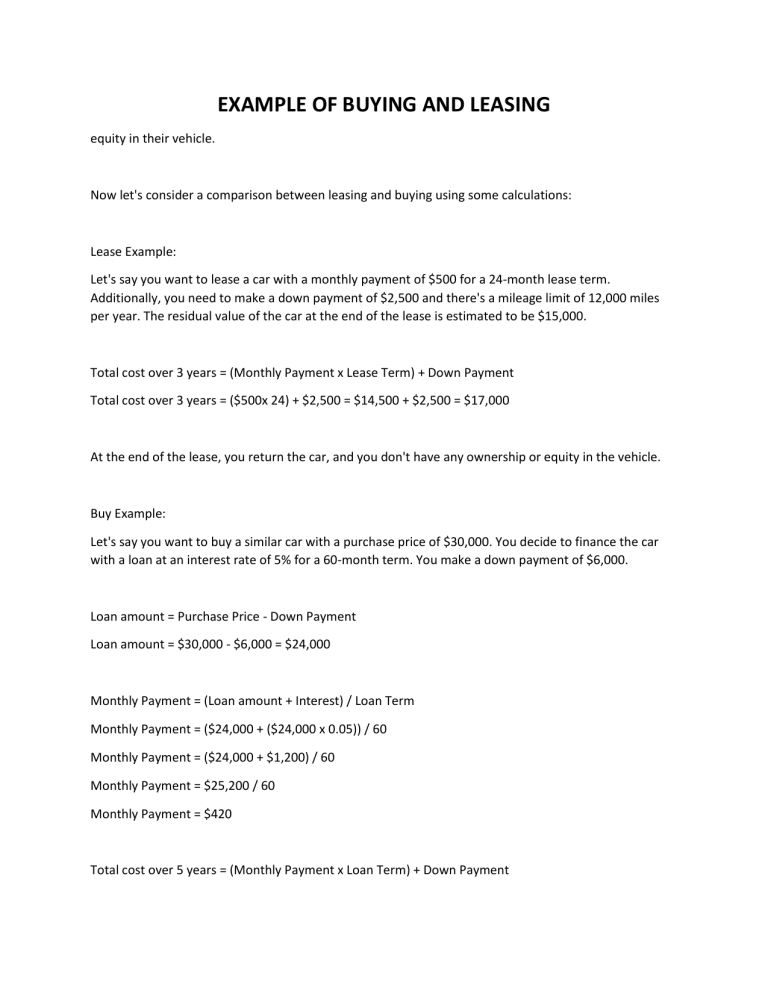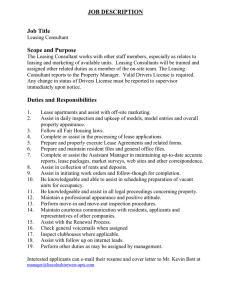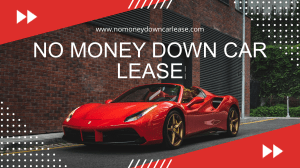
EXAMPLE OF BUYING AND LEASING equity in their vehicle. Now let's consider a comparison between leasing and buying using some calculations: Lease Example: Let's say you want to lease a car with a monthly payment of $500 for a 24-month lease term. Additionally, you need to make a down payment of $2,500 and there's a mileage limit of 12,000 miles per year. The residual value of the car at the end of the lease is estimated to be $15,000. Total cost over 3 years = (Monthly Payment x Lease Term) + Down Payment Total cost over 3 years = ($500x 24) + $2,500 = $14,500 + $2,500 = $17,000 At the end of the lease, you return the car, and you don't have any ownership or equity in the vehicle. Buy Example: Let's say you want to buy a similar car with a purchase price of $30,000. You decide to finance the car with a loan at an interest rate of 5% for a 60-month term. You make a down payment of $6,000. Loan amount = Purchase Price - Down Payment Loan amount = $30,000 - $6,000 = $24,000 Monthly Payment = (Loan amount + Interest) / Loan Term Monthly Payment = ($24,000 + ($24,000 x 0.05)) / 60 Monthly Payment = ($24,000 + $1,200) / 60 Monthly Payment = $25,200 / 60 Monthly Payment = $420 Total cost over 5 years = (Monthly Payment x Loan Term) + Down Payment Total cost over 5 years = ($420 x 60) + $6,000 = $25,200 + $6,000 = $31,200 At the end of the 5-year loan term, you have full ownership of the vehicle, and if you decide to sell it, you may recoup some of the purchase price to regain equity. COMPARISON BETWEEN BUYING AND LEASING Ownership: When buying a vehicle, you become the owner. You have complete control of the car, can modify it as you wish, and can sell it whenever you want. With leasing, you don't own the vehicle. Instead, you pay for the right to use it for a fixed period, typically around 2-4 years. Monthly Payments: Lease payments are generally lower than monthly loan payments when buying a vehicle. This is because you're only paying for the depreciation and not the full cost of the car. Buying a vehicle often requires a larger down payment and higher monthly payments to cover the full cost of the car. Depreciation: When you buy a car, you bear the depreciation costs. As the vehicle ages, its value decreases, and when you decide to sell it, you may not recoup the full purchase price. In a lease, you don't have to worry about the resale value as you will return the car to the dealer after the lease term ends. Long-Term Cost: While leasing may have lower monthly payments, it can be more expensive in the long run. Once the lease term is over, you have nothing to show for the money you've spent. Buying a car allows you to build equity in the vehicle, and you can sell it to recover some of the initial costs. Lower Monthly Payments: Leasing generally offers lower monthly payments compared to buying because you're only paying for the vehicle's depreciation during the lease term, rather than the full cost of the car. This can be beneficial for individuals with budget constraints or who prefer lower monthly expenses. Ability to Drive a New Car: Leasing allows you to drive a new car every few years, as lease terms usually last for 2-4 years. This can be appealing for those who enjoy the latest features, technology, and styling without the commitment of long-term ownership. Reasons for leasing and not leasing. Leasing Lower Monthly Payments: Leasing generally offers lower monthly payments compared to buying because you're only paying for the vehicle's depreciation during the lease term, rather than the full cost of the car. This can be beneficial for individuals with budget constraints or who prefer lower monthly expenses. Not leasing Lack of Ownership: Leasing means you don't own the vehicle. It's like renting, so you don't have the ability to build equity or sell the car to recoup some of its value. Some individuals prefer the sense of ownership and the ability to customize, modify, or sell the car as they please. While leasing generally has lower monthly payments, it can be more expensive in the long run. Once the lease term ends, you have no equity or ownership in the vehicle, and you need to lease or buy another car to continue driving. Buying allows you to eventually own the car and potentially sell it, recouping some of the initial costs. Advantages and disadvantages . Lower Monthly Payments: Lease payments are typically lower compared to buying because you only pay for the car's depreciation over the lease term, rather than the full purchase price. 2. Access to Newer Vehicles: Leasing allows you to drive a new car with the latest features and technology every few years. This can be appealing for individuals who prefer to have a newer model and avoid the potential maintenance and repair costs associated with older vehicles. 3. Limited Repair Costs: Most lease terms coincide with the manufacturer's warranty, which often covers repair costs. This can help reduce out-of-pocket expenses for unexpected repairs. 4. Flexibility: Leasing provides flexibility at the end of the lease term. You can choose to return the vehicle and lease a new one, buy the leased vehicle at a predetermined price (the residual value), or simply walk away. Disadvantages of Leasing: 1. No Ownership or Equity: When you lease a car, you don't own it. You're essentially renting the vehicle for a predetermined period. This means you won't build equity and have no asset to sell or trade-in at the end of the lease. 2. Mileage Restrictions and Penalties: Leasing agreements often come with mileage limits, typically around 10,000 - 15,000 miles per year. If you exceed these limits, you'll incur additional charges per mile, which can add up quickly for individuals with long commutes or frequent road trips. 3. Limited Customization: When leasing, you may face restrictions on modifications or customizations, as you're expected to return the vehicle in its original condition. If personalizing your car is important to you, buying may be a better option. 4. Potential Fees and Charges: Leasing contracts may include various fees, such as lease initiation fees, disposition fees at the end of the lease, and excess wear-and-tear charges. It's important to thoroughly review the lease agreement to understand and account for these potential costs. 5. Long-term Cost: While lease payments may be lower, leasing can be more expensive over a longer period compared to buying. When you buy a car, you eventually reach a point where you no longer have monthly payments, and you can sell the vehicle to recoup some of its value. With leasing, you'll continue to have monthly payments as you lease successive vehicles. It's crucial to carefully consider your financial circumstances, driving habits, and personal preferences when deciding whether to lease or buy a vehicle. Evaluating the advantages and disadvantages in relation to your specific situation will help you make an informed decision.





